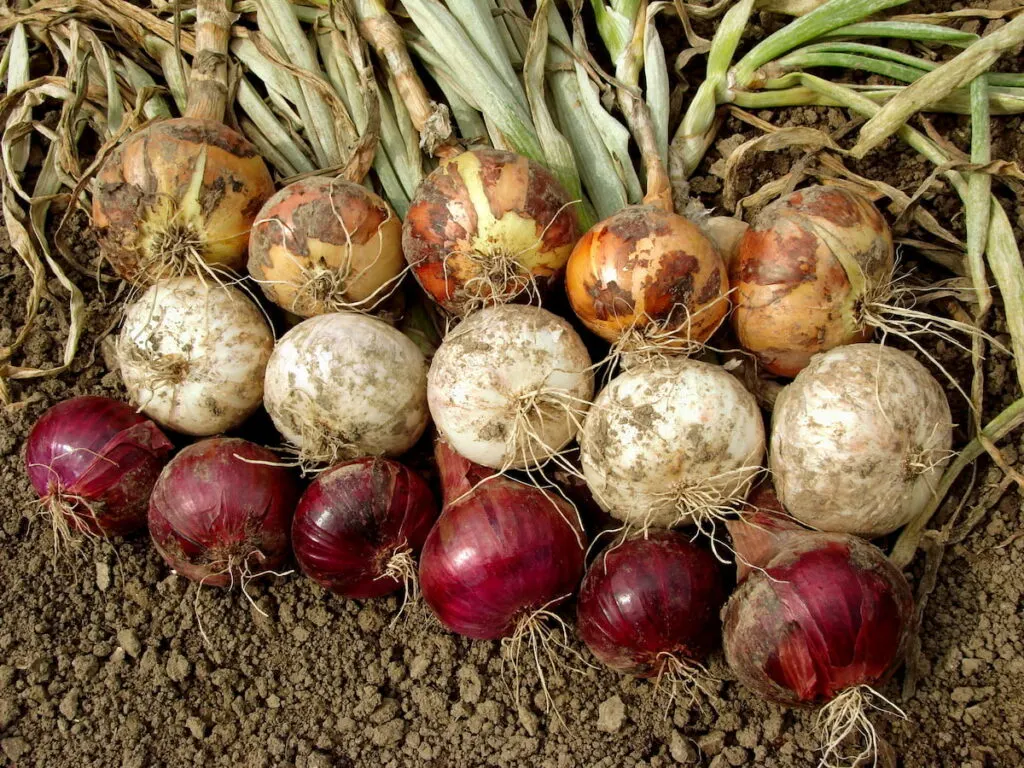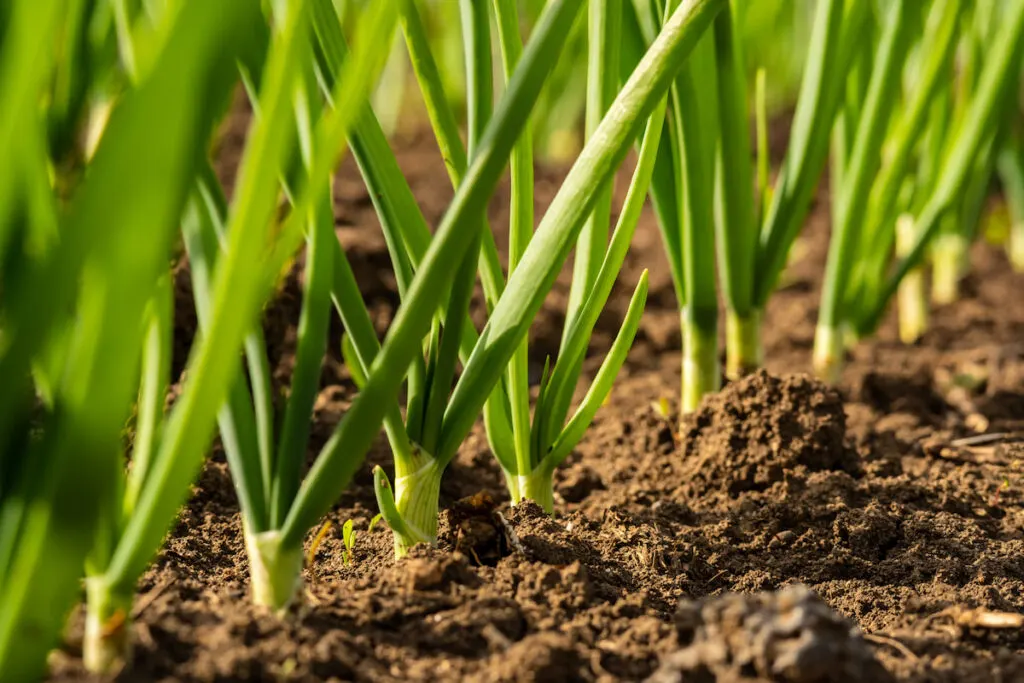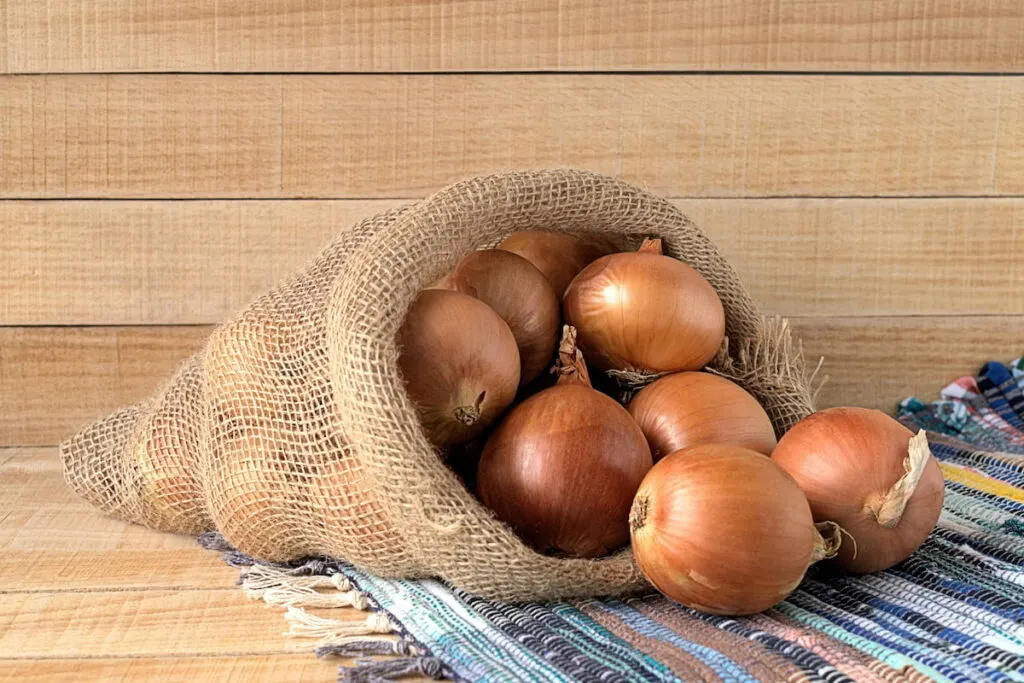Onions are the base of most delicious dishes like soups, salads, and different sandwiches. Apart from their delightful flavor and multiple uses, onions are also easy to grow and harvest.
You don’t need a huge farm to start growing onions. They can be grown in your small backyard garden or pots.
In this detailed guide, we cover some of the common types of onions, when to plant them, and how to know when your onions are ready for harvest.

Table of Contents
Seed Vs Bulb
When growing onions, you have two options to plant from a seed or use the bulb as a transplant.
You can purchase onion seeds from a supplier.
Onions grow easily from seed. Seeds can be planted in the ground in early spring or started under lights in grow station and later transplanted in the ground. Gardeners also use onion sets, which is a live dormant onion bulb started from the seed one year earlier.
Onion sets are planted in early spring once the soil is ready. Gardeners don’t allow onion sets to mature, they are harvested as immature bulbs and kept dormant until the next spring when they are ready to be planted.
After planting bulbs, they mature into onions during the second year.
One thing to note is that onions mature and seed within two years. In the first year, an onion grows from a small seed to a bulb. However, if the seeds are planted early, bulbs mature and can be harvested that year.
Allowing the bulb to overwinter means that it will resume its growth in the second year. The bulb then matures to a full growth cycle.
Should You Use Seeds or Bulbs?

The choice of whether to use the seed or bulb depends on your particular climate, the type of onions you want to grow, and the hours of daylight the onion will get.
Onion sets or immature bulbs have a head start on their growth, which means you can harvest your onions sooner. Nonetheless, onion sets have a limited variety. You’ll typically only come across purple, white, and yellow varieties.
On the other hand, onion seeds are readily available and come in a range of varieties. However, it can be tedious to plant seeds and they take time to grow and mature into full onions.
Additionally, you need to sow the seeds in late winter or fall in warmer climates.
It’s best to use onion sets or immature bulbs to get a head start. Also, using bulbs makes bed care and weeding simpler.
Basic Overview: Types of Onions
Onions are adapted to respond to specific lengths of days and nights. That’s what dictates if they will form bulbs, flowers, and produce seeds.
Onions are categorized into three basic types, mainly short-day, long-day, and neutral-day types. Each of these onion types grows better in a specific region and not others.
For example, an area like San Francisco does well with long-day onions as the state has long summer days.
Growing the Three Types of Onions

Here’s everything you need to know about these three types of onions.
Short-Day Varieties
Short-day onions develop bulbs when exposed to 10-12 hours of daylight. These onions thrive well in southern regions.
When planted in cooler areas during the spring, the bulbs mature in 75 days, while they take up to 110 days when planted in the fall in warm climates.
Some of the short-day onion varieties include:
- White Granex
- Yellow Granex
- Georgia Sweet
- White Bermuda
- Texas Sweet White
- Sweet Red
- Texas Legend
- Early Strasberg
- Texas Early White
- California Early Red
Long-Day Varieties
Long-day onion varieties are planted in early spring or winter. This variety needs at least 14-16 hours of daylight and tends to mature in 90-100 days when planted in northern regions. Some of the onions that fall under this variety include:
- Yellow Sweet Spanish
- White Sweet Spanish
- Walla Walla
- Yellow Globe Danvers
- Red Cipollini
- Zittan Yellow
- Yellow Flat Grant
- Southport Red Globe
- Yellow Rynsburg
Day-Neutral Varieties
Day-neutral onions require 12-14 hours of daylight to form bulbs. They thrive well in northern climates when planted in early spring or mild winter climates.
Additionally, these onions take up to 110 days to mature. Day-neutral onion varieties can grow anywhere.
Common day-neutral onions include:
- Super Star
- Candy Onion
- Australian Brown
- White Portugal
- Early Yellow Globe
- Italia Red Madeira
- Southport Yellow Globe
3 Recommended Varieties

Some of the recommended onion varieties include:
- Walla Walla – Walla Walla falls under the long-day variety and is resistant to disease. The onions produce uniform bulbs with white flesh.
- Red Baron – Red baron rakes 115 days to mature and produces three-inch bulbs.
- Yellow Cipollini – Yellow Cipollini matures in 80 days and has a unique flavor.
Where to Buy Onion Bulbs/Seeds
You can purchase onion seeds or bulbs at a local garden center. Stores like Walmart also stock onion sets.
When to Plant
Onions are hardy plants that can grow at any time of the year.
However, most onion growers prefer planting seeds in early fall or late summer for an overwintered spring harvest. Some will also plant seeds in early spring and harvest them in early summer.
It’s essential to know the day length for bulbing if you’re to get the timing right. That’s because onions require a given number of daylight hours in their growing season for them to form proper bulbs.
Although onion bulbs can be planted when the soil is ready during spring, you should wait until the nighttime temperature is above 28 degrees Fahrenheit. Additionally, the soil temperatures need to be between 60 degrees to 85 degrees Fahrenheit to increase the chance of germination.
Best Type of Soil ( in-ground vs raised bed)

Onions perform well in soil with a 6.2-6.8 pH. Add limestone to soil that’s too acidic and consider getting peat moss if you have alkaline soil.
Find well-drained and fertile soil to grow your onions. Properly-drained soil prevents root-rotting in hot weather. Check if the top part of the soil is loose to allow good drainage.
You can add compost to improve heavy soil drainage and fertility. You’ll notice that onions require high fertility levels, unlike other vegetables.
If you have heavy clay soil, consider building raised rows or raised beds. Ensure that you fill the raised bed with soil that has the right texture and weight to support onion growth.
How Much Water Do Onions Require?
Onion plants are hardy and don’t need a lot of water if you’ve already used mulch. Although onions need enough water to produce a high yield, overwatering them can make them rot in the ground or become diseased. Onions require an inch of water per square foot every week.
Ensure that the soaking is up to six inches each week, just enough to keep the soil soggy, but not overwatered. You should keep the soil moist until the seedlings pop up or until the bulbs take hold. Don’t forget to reduce the watering when the tops start to die back as this prevents the bulbs from rotting.
When should you water your onions? it’s better to water your onions early in the morning and not during the day. Also, watering the onions in the evening leaves them with wet foilage, which can spread disease as the moisture remains on the leaves.
How Much Sun Do Onions Need?
Onions during the early stages of growth require plenty of sunlight. Bulb onions need at least eight to ten hours of sunlight daily to maximize crop production and prevent the spread of pests and diseases.
Although some varieties like scallions can grow in indirect sunlight, most varieties thrive where there’s enough sunlight.
Onions that are grown in partial sunlight or a shaded space may develop yellow, white, or gray spots. The bulbs are also smaller, although they may have a normal color. Lack of enough sunlight when combined with soggy soil and hot weather may lead to a fungal disease. You’ll notice that the seedlings will fall over as they lack structural strength.
Preparing the Planting Site

Find a location with full sun and with loose and well-drained soil. When you’re about to plant, add an inch of compost to the bottom of each row. Alternatively, dig about two inches deep and fill the trench with an inch of compost.
If you’re using onion sets, choose those that are ¾ inch in diameter and plant them two to six inches apart. When using larger bulbs, space them four to five inches apart. Make sure that the bulbs are an inch under the soil and not deeper than this as it can interfere with bulb development.
Caring for Onions
Although onions are a leaf crop that can survive in any region, they still do need care.
Once you notice the bulbs are developing, mulch with half an inch layer of straw to suppress the weeds and help the soil retain moisture. Mulching also aids in air circulation, especially if you’re in a humid area.
Fertilize the onions after a few weeks with nitrogen to promote growth. Stop fertilizing when the bulbing process starts. Remove flower spikes and any weeds when you notice them.
Onions look vibrant even during the dry weather. Ensure that you water the plants during this season to prevent them from bolting.
How Long Until Harvest?
Learning how long to wait until harvest time is crucial. You can know that your onions are near harvest time when the lower leaves of the plants begin to dry up and wither. The stems will also fall over to indicate that the bulbs are fully developed and are ready to harvest.
If you planted your bulbs in autumn, they should be ready to harvest by early to mid-summer. Spring-planted sets are ready for harvest in late summer to the early days of autumn.
Stop watering if you notice that the tops have fallen over. Leave the onions in the ground for at least a week.
Harvest your onions before all the foliage is gone. Use a fork to lift the bulbs carefully, making sure that you don’t bruise or damage them.
How to Store Onions so they Last

Curing preserves onions and gives them a longer storage life.
Here are some more tips to store onions so they last.
- Wait Until the Foilage is Dry and Papery – Wait until the onion stems start to wither and the papery skin tightens around the onion. That’s when the onions are ready for storage.
- Store Harvested Onions in a Shaded Location – Provide a shaded and protected space to lay down your onions. If storing them indoors, ensure the space has some slight breeze. Place the onions in a single layer on the floor or preferred rack for them to cure.
- Place the Onions in Trays or Net Bags in a Dry and Cool Space – After drying the onions, it’s time to store them in a well-ventilated, cool, and dry space. You can use trays lined in a single layer or use net bags. A temperature range of 40-80 degrees Fahrenheit is preferable. Avoid storing the onions in a dark space as it promotes sprouting.
- Throw away onions that show signs of damage or decay as they can affect other onions when stored together. If you’re planning on storing onions over winter, ensure that you cure them by placing them in an aerated space. Leave the onions to hang for about three weeks.
- Note that sweeter varieties won’t store longer, which is why you should use them first and preserve the pungent onion varieties for later.
- Avoid storing onions with potatoes or other fruits as they may spoil their flavor.
